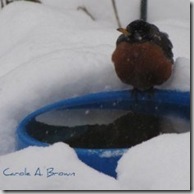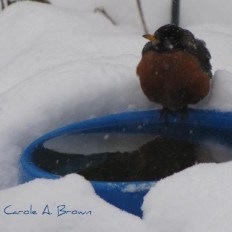 Split bark, broken branches, and winter burned foliage – it’s enough to make any gardener long to take refuge in a warmer climate. However, a little knowledge can go a long way towards preventing and repairing storm damage. By treating your plants properly in summer and fall, you can help plants harden off and become immune to much of the damage. And once the cold weather has had its way with your landscaping, there are things you can do to repair any problems.
Split bark, broken branches, and winter burned foliage – it’s enough to make any gardener long to take refuge in a warmer climate. However, a little knowledge can go a long way towards preventing and repairing storm damage. By treating your plants properly in summer and fall, you can help plants harden off and become immune to much of the damage. And once the cold weather has had its way with your landscaping, there are things you can do to repair any problems.
What snow damage looks like in the landscape
Snow and freezing temperatures can cause your trees, shrubs and plants all kinds of problems.
Broken branches and split tree trunks. A heavy snow can put so much weight on plants that it breaks branches and even splits the trunks of trees. Older trees which may be brittle, and younger trees which can’t support so much weight, may bend to the ground and sometimes break. Bark can be ripped away when a snow-covered branch breaks off a tree or shrub, causing an open wound that can be tough to heal.
Frost cracking and bark split. A sudden sharp drop in temperature between daytime and night can actually freeze water that is sitting in the craggy trunk of a tree. This can cause the tree to split open, which is called frost cracking. If the damage isn’t too bad, the crack may close when it warms, but the wood fibers inside the trunk may not grow back together again. Because this damage is often found on the southwest side of shade trees (the warm afternoon sun can cause extreme swings in the temperature), frost cracking is also known as southwest injury. Called bark split in shrubs, it’s much less serious than when it occurs in trees, because the cracks will often close up on their own, making treatment unnecessary.
Bud injury on flowering shrubs. If you have a flowering tree or shrub, a deceptively sunny day can cause buds to open prematurely. If there’s a freezing temperature that night, this may kill some or all of the buds. Bud injury most commonly occurs in winter on more tender dormant trees and shrubs. Though the flowering buds may be damaged by the cold, the leaf buds are hardier and usually make it through just fine.
Root injury. Plants in containers or raised planters can be damaged by temperatures as low as 28° F. Because their roots are less protected in a raised area or container, plants in these settings are more likely to outright die than ones in the ground. If you have tender plants, it’s best to bring them indoors or otherwise protect them in the winter. In raised beds, a thick layer of mulch can help. With containers, consider setting them on a wheeled stand so they are easy to roll into the garage or another protected space.
Snow and frost damage on evergreens
Most people think that evergreens are so hardy that snow and freezing temperatures wouldn’t bother them, but it’s really not true. Your evergreens can suffer from winter discoloration and bleaching.
What causes winter discoloration? When the winter sun comes out and the wind blows, foliage can quickly lose water and become desiccated. Since the roots are frozen in the soil, they can’t replace the water that’s been lost. This causes the needles to turn dry and brown. An occasional bright sunny day also can cause problems. The sunshine warms up the plant to where the cells become active again, then when the temperature inevitably drops, foliage is damaged or killed. This can destroy the chlorophyll, causing a bleached look.
How to prevent winter discoloration and keep evergreens safe
- Don’t plant evergreens in windy, highly exposed places.
- Construct a burlap barrier on the south, southwest, and windward sides of your evergreens to protect from wind burn. If your tree or shrub is prone to injury on all sides, you can encircle it with burlap (Dewitt is a good brand), but leave the top open for air and light penetration.
- Anti-desiccant and anti-transpirant sprays can also be used to help prevent winter burn, but they aren’t 100% effective (Wilt-Pruf is a good one).
- If your tree or shrub has been injured, prune out the injured foliage in midspring, but never before because the old foliage helps protect the rest of the plant. When pruning, if the foliage is brown, it’s most likely dead, but on some varieties of plant, buds may grow and fill in the brown areas. If everything is dead, then prune it back to a living part of the shrub.
- Water all injured plants regularly throughout the spring, and fertilize after the threat of frost has passed.
Snow damage on deciduous trees and shrubs
Once again, you might think that deciduous shrubs and trees would not be damaged by snow, since their leaves have already fallen, but unfortunately snow can damage flower and leaf buds even before they open. Flower buds are more delicate than vegetative buds, so if flower buds are damaged, don’t panic, because your shrub is likely still going to be okay.
The best prevention for damaged buds on deciduous trees and shrubs is to care for your plants differently during the growing season. If your plant is over watered or over fertilized in the fall, it can develop weak buds that are more likely to be damaged, so cut off the fertilizer by the end of summer and make sure you are allowing plants to have a natural wet-dry cycle rather than keeping the soil constantly moist.
There are also frost protective covers that can be used if you are expecting a severe, sudden frost, but it is a real pain to wrap and unwrap plants for every frost, so the better plan is to plant hardy plants and avoid a situation where they develop cushy, weak buds that are likely to be damaged.
Other winter tips for repairing snow damage
- When you have heavy snow and ice on your trees and shrubs, don’t shake it off. Wait for the storm to pass. If it’s snow on your plants, take a broom and sweep upward to lift the snow off; don’t sweep downward, or you’ll most likely break a branch. If it’s ice and your branches are still and brittle, don’t do anything; wait for a little warmer weather or until most of the ice melts away.
- Prune at the proper time of year to reduce snow damage in the landscape. Remove any v-shaped, weak, or places where the branches meet at a narrow angle, as these areas can easily break if water freezes and forces the branches to split, or if the tree or shrub can’t tolerate a heavy snow load. Avoid pruning in late summer because new, weak growth will be stimulated. This growth will use up some of the plant’s much needed energy and is more susceptible to damage.
- If a small tree or shrub is uprooted, you can right it and secure it with stakes and guy wires. Just make sure there is at least one third to half of the root ball intact.
- If the bark is ripped from your tree or shrub, carefully trim away any loose bark. Trim it in the shape of an ellipse and avoid damaging the woody part of the trunk. Pruning paints and sealants are not recommended, as they can actually make it harder for the plant to heal. It would be like wearing a Band-Aid and expecting a scab to grow over the top.
- Keep your evergreens watered appropriately through the growing season and into the fall. In fall, decrease watering slightly so your plant hardens off. Water until the first freeze, then discontinue because watering after that won’t help to reduce the amount of winter injury.
Winter isn’t just hard on you, but it’s hard on your trees, plants and shrubs as well. By using some preventive measures, you can avoid much of the damage that the snow and freezing temperatures bring.
Related reading:
Snow-Loading on Arborvitae: Repairing the Damage
Photo credit: Carole Brown at Ecosystem Gardening

4 responses to “Repairing and Preventing Snow Damage in the Landscape”
Ahhh. Winter damage, one of those thing we learn to live with. It seems my major issue every year is the damage from from the heavy, wet frozen snow sitting on the branches and bending them down out op there normal growth . I guess I could prune a little heavier to prevent some of the damage. Thanks for the tips!
Great tips! Timely article for us as we live in Buffalo, NY where we were hammered with snow this year. For the past 3 years, our winters were so harsh, that we lost all our front bushes =( And this year, even though it is FINALLY going to be about 35 degrees today (practically warm) we still have about 3 feet of snow piled everywhere. It’s crazy!
Thanks, Laura! 🙂
3 feet of snow – eeek! So an article on pruning perennials would not go over well at this moment? Lol. 🙂
Using burlap is a great idea! I will try that this winter!